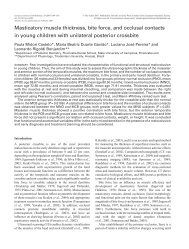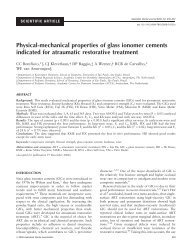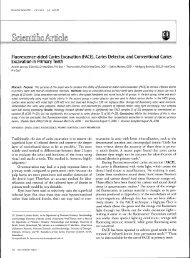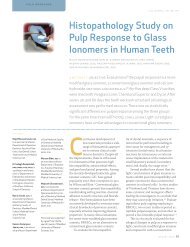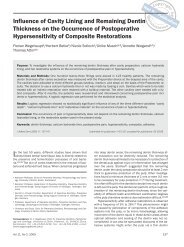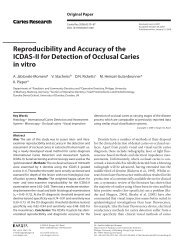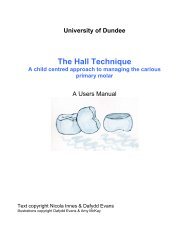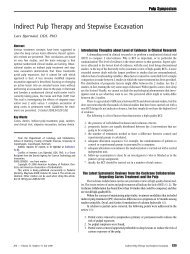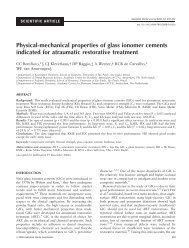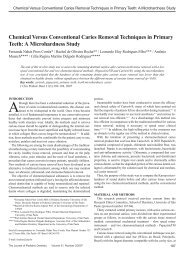Pit and Fissure Sealants in the Prevention of Dental Caries in ...
Pit and Fissure Sealants in the Prevention of Dental Caries in ...
Pit and Fissure Sealants in the Prevention of Dental Caries in ...
Create successful ePaper yourself
Turn your PDF publications into a flip-book with our unique Google optimized e-Paper software.
––– <strong>Sealants</strong>: <strong>Prevention</strong> <strong>of</strong> <strong>Caries</strong> –––<br />
Citation: Bravo M, Montero J, Bravo JJ, Baca P, Llodra JC. Sealant <strong>and</strong> fluoride varnish <strong>in</strong> caries: a r<strong>and</strong>omized trial.<br />
J Dent Res 2005; 84(12):1138–43.<br />
Population: 350 children recruited <strong>in</strong> 1990<br />
Characteristics <strong>of</strong> children (n = 120) who rema<strong>in</strong>ed <strong>in</strong> <strong>the</strong> study after 9 years:<br />
• Age (mean ± st<strong>and</strong>ard deviation): 7.4 ± 0.7 for control group, 7.3 ± 0.8 for sealant group, 7.6 ± 0.7 for fluoride (F)<br />
varnish group<br />
• Sex: 51.1% females for control group, 67.6% females for sealant group, 47.4% females for F varnish group<br />
• Location: Granada, Spa<strong>in</strong> (no fluoridation)<br />
• Representative <strong>of</strong> middle-class children <strong>in</strong> Granada, Spa<strong>in</strong><br />
Intervention:<br />
• n = 105 children, Delton light-polymerized opaque fissure sealant (Johnson & Johnson <strong>Dental</strong> Products Co., East<br />
W<strong>in</strong>dsor, N.J.) applied to all healthy, permanent, fully erupted first molars; after 6, 12, 18, 24 <strong>and</strong> 36 months,<br />
sealant was applied to newly erupted molars <strong>and</strong> was replaced if <strong>the</strong>re had been partial or total loss.<br />
• n = 110 children, Duraphat fluoride varnish (Colgate-Palmolive Co., New York, N.Y.) was applied to all healthy<br />
permanent first molars with partially or fully erupted occlusal surfaces; after 6, 12, 18, 24, 30, 36 <strong>and</strong> 42 months,<br />
varnish was applied to newly erupted molars <strong>and</strong> was reapplied to all molars that had rema<strong>in</strong>ed healthy.<br />
Control: n = 135 children<br />
Outcomes: Follow-up after 9 years; only those with at least one sound <strong>and</strong> fully erupted permanent first molar who<br />
were exam<strong>in</strong>ed at both <strong>the</strong> 4-year <strong>and</strong> <strong>the</strong> 9-year follow-up were <strong>in</strong>cluded for analysis.<br />
• Loss to follow-up: 51% <strong>in</strong> control group, 52% <strong>in</strong> sealant group, 55% <strong>in</strong> F varnish group<br />
• 120 children for analysis at 9-year follow-up (45 <strong>in</strong> control group, 37 <strong>in</strong> sealant group <strong>and</strong> 38 <strong>in</strong> F varnish group),<br />
371 molars (129 <strong>in</strong> control group, 113 <strong>in</strong> sealant group <strong>and</strong> 129 <strong>in</strong> varnish group)<br />
No significant differences <strong>in</strong> sex, age, social level or basel<strong>in</strong>e caries scores between <strong>the</strong> followed children <strong>and</strong> <strong>the</strong> 185<br />
lost to follow-up<br />
No significant difference <strong>in</strong> <strong>the</strong> average number <strong>of</strong> exam<strong>in</strong>ation visits per child (8.75; st<strong>and</strong>ard deviation [SD] 0.55),<br />
exclud<strong>in</strong>g <strong>the</strong> 9-year follow-up visit<br />
Average number <strong>of</strong> treatment visits per child dur<strong>in</strong>g <strong>the</strong> active phase <strong>of</strong> <strong>the</strong> programs:<br />
• 2.24 (SD 1.14) for sealant group<br />
• 7.26 (SD 0.98) for F varnish group<br />
Occlusal caries at 9 years:<br />
Significant difference between <strong>the</strong> groups, adjusted for multiple molars with<strong>in</strong> each child <strong>and</strong> cluster (school classes<br />
ra<strong>the</strong>r than children) r<strong>and</strong>om allocation (p < 0.001)<br />
• Control: 76.7%; decayed (D) = 59, miss<strong>in</strong>g (M) = 4, filled (F) = 36, filled occlusal surfaces that had been declared<br />
sound at <strong>the</strong> previous visit = 12; D = 17, M = 1, F = 12, filled occlusal surfaces that had been declared sound at <strong>the</strong><br />
previous visit = 4<br />
• Sealant: 26.6%<br />
• Varnish: 55.8%; D = 40, M = 0, F = 32, filled occlusal surfaces that had been declared sound at <strong>the</strong> previous visit = 13<br />
Effectiveness <strong>of</strong> treatments:<br />
• At 4 years: 76.3% (st<strong>and</strong>ard error [SE] 7.9%) for sealant vs. control, 43.9% (SE 10.3%) for varnish vs. control, 57.8%<br />
(SE 14.7%) for sealant vs. varnish<br />
• At 9 years: 65.4% (SE 8.5%) for sealant vs. control, 27.3% (SE 10.2%) for varnish vs. control, 52.4% (SE 12.2%) for<br />
sealant vs. varnish<br />
Sealant retention rate (n = 113):<br />
• Complete retention: 44 (38.9%)<br />
• Partial or complete loss: 55 (48.7%)<br />
JCDA • www.cda-adc.ca/jcda • March 2008, Vol. 74, No. 2 • App_183iii





